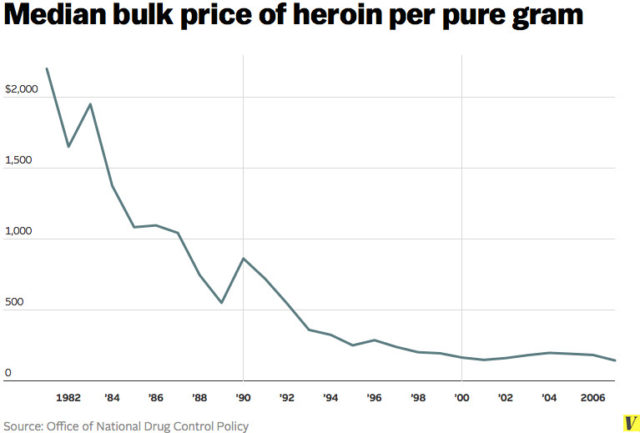The goal of the war on drugs is to reduce drug use. The specific aim is to destroy and inhibit the international drug trade — making drugs scarcer and costlier, and therefore making drug habits in the US unaffordable. And although some of the data shows drugs getting cheaper, drug policy experts generally believe that the drug war is nonetheless preventing some drug abuse by making the substances less accessible.
/cdn.vox-cdn.com/uploads/chorus_asset/file/680036/heroin_price.0.png)
Much of this is explained by what’s known as the balloon effect: Cracking down on drugs in one area doesn’t necessarily reduce the overall supply of drugs. Instead, drug production and trafficking shift elsewhere, because the drug trade is so lucrative that someone will always want to take it up — particularly in countries where the drug trade might be one of the only economic opportunities and governments won’t be strong enough to suppress the drug trade.
The balloon effect has been documented in multiple instances, including Peru and Bolivia to Colombia in the 1990s, the Netherlands Antilles to West Africa in the early 2000s, and Colombia and Mexico to El Salvador, Honduras, and Guatemala in the 2000s and 2010s.
/cdn.vox-cdn.com/uploads/chorus_asset/file/680858/past-month_drug_use_high_school_seniors.0.png)
Still, prohibition does likely make drugs less accessible than they would be if they were legal. A 2014 study by Jon Caulkins, a drug policy expert at Carnegie Mellon University, suggested that prohibition multiplies the price of hard drugs like cocaine by as much as 10 times. And illicit drugs obviously aren’t available through easy means — one can’t just walk into a CVS and buy heroin. So the drug war is likely stopping some drug use: Caulkins estimates that legalization could lead hard drug abuse to triple, although he told me it could go much higher.
The question is whether the possible reduction of potential drug use is worth the drawbacks that come in other areas, including a strained criminal justice system and the global proliferation of violence fueled by illegal drug markets. If the drug war has failed to significantly reduce drug use, production, and trafficking, then perhaps it’s not worth these costs, and a new approach is preferable.







